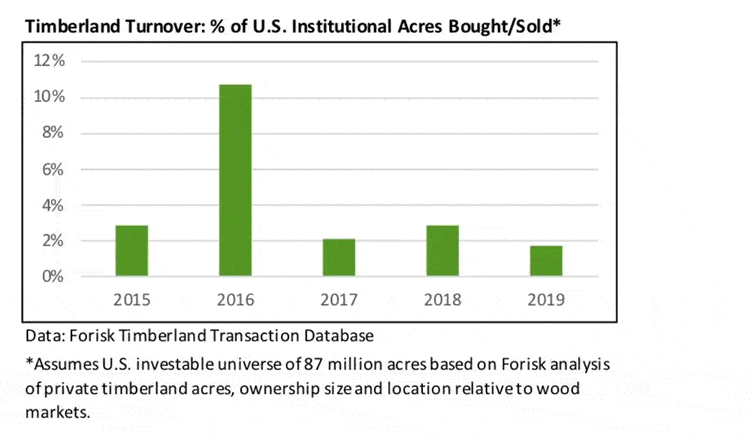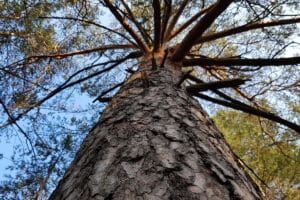Timberland investment vehicles – whether public firms or private funds – vary in performance, liquidity and accessibility. How did these timber firms perform in 2019 and what can we say about the timberland deal flow in private markets headed into 2020?
Timber REIT Returns
Public timber REITs, along with the balance of the stock market, delivered truckloads of cash and returns to investors. After a horrible 2018 (-34.6%), the public timber REIT sector outperformed the S&P 500 and returned 36.2% on share appreciation alone.

At the individual firm level, three of the four public timber REITs generated returns superior to those of the S&P 500 in 2019. CatchMark Timber Trust led the sector by posting a 61.5% gain (not including dividends paid). Dilly dilly.
Timberland Deal Flow
In 2019, one of the most common questions I heard from timberland investors was some version of, “what does a normal timberland deal flow look like in the U.S.?” As part of tracking North American forest ownership, we maintain a database of “institutional” timberland transactions that includes over 600 deals back into the 1990s. We looked at the data and highlight three findings.
- First, U.S. timberlands have a limited universe of investment opportunities. For institutional investors like TIMOs, REITs and large family offices, we estimate approximately 87 million acres of investable, private timberlands in the U.S.
- Second, timberland deal flow is “chunky.” Unlike the buying and selling of homes or office buildings, timberland acres usually trade in small parcels occasionally overshadowed by massive transactions. The figure below summarizes the percentage of the “investable universe” that traded annually over the past five years. The Weyerhaeuser/Plum Creek merger in 2016 spiked the trend, while typically 2 to 3% of the acres trade. On average, 4-5% of the investable acres turn over.

- Third, this rate of turnover aligns with other asset classes such as residential housing. In a typical year, we sell just over 6 million existing and new homes in the United States on an inventory of homes approaching 140 million in total. That means we “turn over” 4-5% of U.S. homes each year. Similar numbers appear in commercial real estate.
While 2019 proved a little light on timberland deal flow, it was not unusual. Timberland markets, over the past three decades with average ownership periods of 20 years or longer, are falling in line with other hard assets. Where does that and timber REIT returns leave us for 2020? Investors want to understand whether or not the recovery in share prices implies that timber REITs and timberlands are now fairly, or dearly, valued relative to the assets and future prospects. Values are a function of estimating and, ultimately, discounting cash flows. Timber REITs and forest owners that strengthen cash flows over time create expectations of higher distributions, high values and higher prices.
This content may not be used or reproduced in any manner whatsoever, in part or in whole, without written permission of LANDTHINK. Use of this content without permission is a violation of federal copyright law. The articles, posts, comments, opinions and information provided by LANDTHINK are for informational and research purposes only and DOES NOT substitute or coincide with the advice of an attorney, accountant, real estate broker or any other licensed real estate professional. LANDTHINK strongly advises visitors and readers to seek their own professional guidance and advice related to buying, investing in or selling real estate.










When I got my first job in forestry in 1967, pine swt in SC selling for about $7/ton. Using gov’t inflation calculator (likely understates), to have the same purchasing power today, NIPF has to get over $53/ton. Today she is lucky to get $25/ton. Given the proclivities of the Federal Reserve and the Federal Gov’t, this destruction of the purchasing power can only get worse. How do the REITs deal with this?